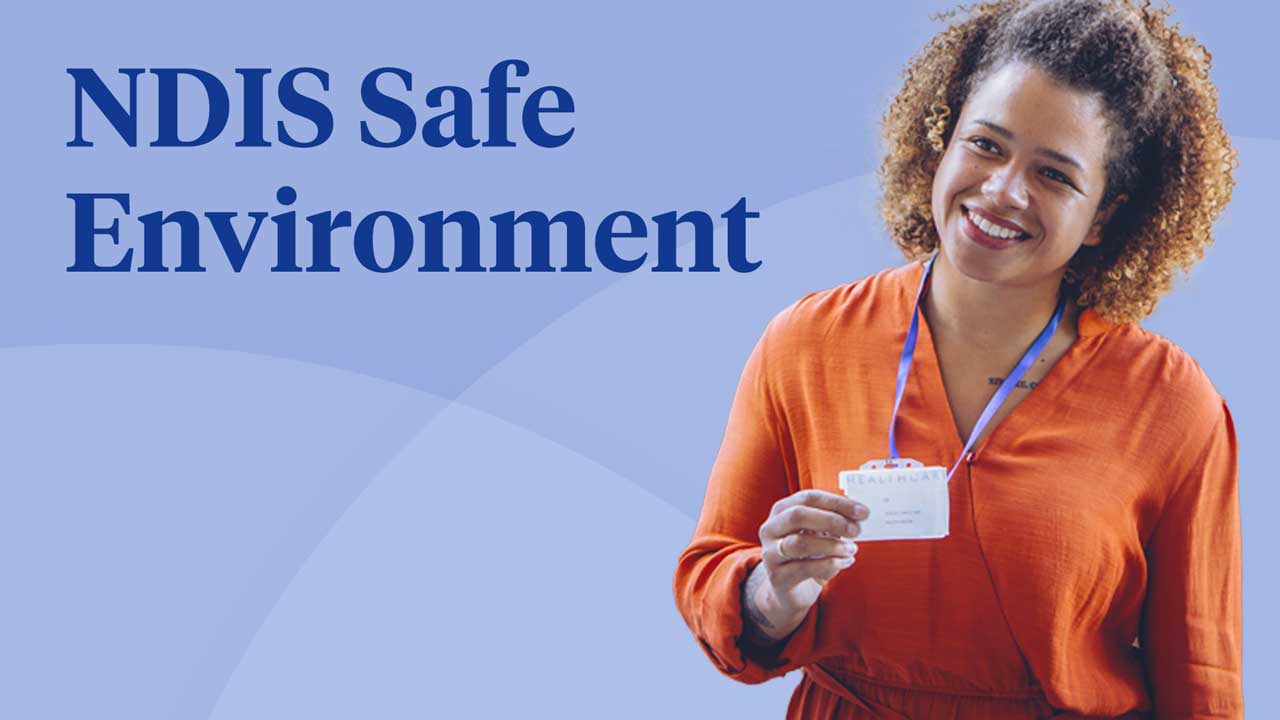Between 2013 and 2018, people using disability support services in Australia were found to have a rate of roughly 240 potentially preventable deaths per 100,000 people - 3.6 times higher than that of the general population (AIHW 2020).
Between 2014 and 2017, 42 preventable deaths occurred in residential disability care in New South Wales alone (NSW Ombudsman 2018).
Participants of the National Disability Insurance Scheme (NDIS) have the right to receive high-quality supports provided with care and skill and delivered in a safe and competent environment (NDIS 2022).
It’s the provider’s responsibility to ensure the safety of their service delivery environment, thereby reducing the risk of injury, illness or death.
Safe Environment in the NDIS Practice Standards
Safe Environment is a requirement of the NDIS Practice Standards under Core Module 4: Provision of Supports Environment.
This Practice Standard aims to ensure that NDIS participants receive care in a safe environment that is appropriate for their needs (NDIS 2021).
Safe Environment Quality Indicators
NDIS providers must meet the following quality indicators:
Identifiable Workers

NDIS participants should be able to easily recognise the workers who have been engaged to provide supports (NDIS 2021).
Providers can ensure that workers are recognisable by:
- Providing staff with photo identification badges or name tags
- Placing the organisation’s logo on staff uniforms
- Providing participants with information packs that contain staff photos
- Placing a staff photo board in reception areas
- Seeking feedback from participants.
(NDS 2020; WAAMH 2021)
These strategies will not only ensure participants feel safer but may also help them better understand a particular worker’s credentials and role within the organisation (Avon Security Products 2017).
Safety in the Participant’s Home
Read: Lone Working Safety in the Home
If supports are being delivered within a participant’s home, the provider must work with the participant to ensure that their home is adequately safe (NDIS 2021).
Any potential risks in the participant’s home must be identified and managed to prevent harm to the participant, workers or anyone else present (WAAMH 2021).
Examples of potential safety hazards in a participant’s home include:
- Manual handling tasks
- Equipment
- Environmental hazards that could cause slips, trips, falls, etc.
- Hazardous substances
- Temperature (e.g. heat or cold)
- Confined spaces
- Noise, light or electricity
- The participant’s relatives, friends, neighbours or pets
- Weapons and objects
- The participant’s behaviour.
(Mable 2018)

It’s important that a risk assessment is performed prior to delivering supports at a participant’s home (WAAMH 2021).
Collaboration with Other Providers and Services
Providers are expected to collaborate with other providers and services involved in a participant’s care to identify and mitigate risks, ensure the safety of the service environment, and prevent and manage injury (WAAMH 2021).
This also applies if a provider operates in an environment that it does not own, such as a community setting (NDS 2020).
Reducing Preventable Deaths in Disability Care
A 2018 report by the NSW Ombudsman identified the following actions to reduce preventable deaths in disability care:
- Identifying illness or injury and urgently seeking medical assistance
- Improving access to preventive health services (e.g. related to smoking, obesity and other lifestyle risks)
- Identifying and managing breathing, swallowing and choking risks
- Making informed treatment limitation decisions instead of basing decisions on perceived quality of life
- Ensuring effective first-aid responses
- Improving the support and coordination of care in hospital
- Reporting ‘near misses’ and taking action to prevent these situations from reoccurring
- Providing behavioural support to reduce aversion and resistance to health services and treatment
- Reducing medicine-related risks, such as medication errors and improper storage.
Test Your Knowledge
Question 1 of 3
Which one of the following actions was identified by the NSW Ombudsman to help reduce preventable deaths in disability care?
Topics
References
- Australian Institute of Health and Welfare 2020, Mortality Patterns Among People Using Disability Support Services: 1 July 2013 to June 2018, Australian Government, viewed 27 August 2024, https://www.aihw.gov.au/reports/disability-services/mortality-patterns-of-people-using-disability-serv/contents/summary
- Avon Security Products 2017, ‘The Importance of Name Badge Holders in The Healthcare Industry’, Avon Security Products Blog, 7 February, viewed 27 August 2024, https://www.avonsecurityproducts.com/blog/the-importance-of-name-badge-holders-in-the-healthcare-industry.html
- Mable 2018, Home Visiting Guide, Mable, viewed 27 August 2024, https://mable.com.au/wp-content/uploads/2020/10/HOME-VISITING-GUIDE-.pdf
- National Disability Services 2020, NDIS Practice Standards Interpretive Guide, NDS, viewed 27 August 2024, https://www.nds.org.au/images/resources/NDIS-Practice-Standards-Interpretive-Guide_singlepages.pdf
- NDIS Quality and Safeguards Commission 2021, NDIS Practice Standards: NDIS Practice Standards and Quality Indicators, Australian Government, viewed 27 August 2024, https://www.ndiscommission.gov.au/sites/default/files/2022-02/ndis-practice-standards-and-quality-indicatorsfinal1_1.pdf
- NDIS Quality and Safeguards Commission 2022, Research: Deaths of People with Disability, Australian Government, viewed 27 August 2024, https://www.ndiscommission.gov.au/resources/reports-policies-and-frameworks/research-deaths-people-disability
- NSW Ombudsman 2018, Report of Reviewable Deaths in 2014 and 2015 2016 and 2017: Deaths of People With Disability in Residential Care, New South Wales Government, viewed 27 August 2024, https://www.ombo.nsw.gov.au/Find-a-publication/publications/annual-reports-relating-to-former-functions/reviewable-deaths-of-people-with-disability-annual-reports-2003-2022/report-of-reviewable-deaths-of-people-in-2014-2017-deaths-of-people-with-disability-in-residential-care
- Western Australian Association for Mental Health 2021, Readiness Workbook: NDIS Practice Standards & Quality Indicators, WAAMH, viewed 27 August 2024, https://waamh.org.au/assets/documents/sector-development/ndis-qsc-sector-readiness/waamh-ndis-readiness-workbook-interactive-final-1-.pdf
 New
New 
